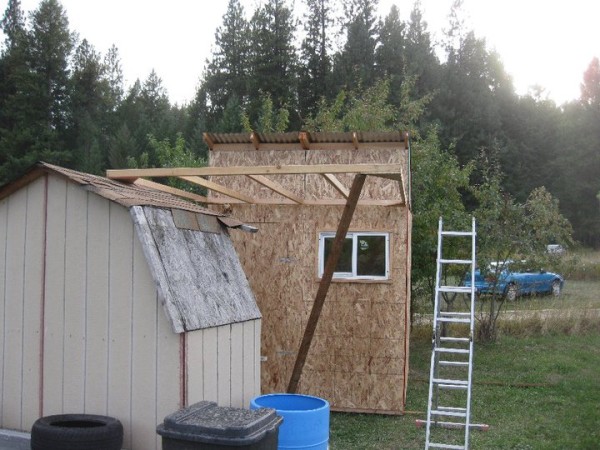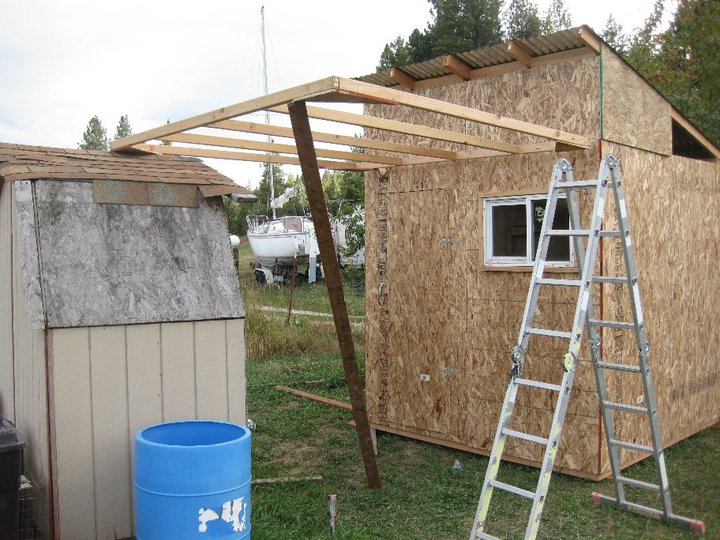Kevin a friend of mine on facebook has been designing and building a prototype of a micro homestead with a barn and garden area, solar powered, with saw dust toilet and propane heat and a micro kitchen area. Portable and able to knock down and setup in 30 minutes using off the shelf materials skill level …easy.
I have borrowed a couple of pictures from his facebook page to share with you and he just put up a cool little video tour on Youtube that I thought you would enjoy. Kevin shows what can be done with low cost and easy to get materials.




I love these Tiny Houses and I am trying to position myself financially to be able to own one eventually. I have a lot of questions about it. But I am trying to educate myself now. Since I am not able to build one on my own I will have to purchase one. Currently I drive a toyota Rav 4 and I am wondering if something like this can be hauled with my Toyota or if I will have to buy another SUV or truck? Also is there licensing requirements and what type of insurance do you need?
When you buy something like this can it be financed or pay cash outright?
Thanks ! Sorry for all the questions.
Mary Jo
Mary jo I would haul this on a small trailer like the ones at home depot or costco and pull it with your current suv,this is free standing so no licence or insurance. this was inexpensive to build and you could do it with hand tools very simply.that was part of the purpose. ask all the questions you like here is my email kevin@mobile-clean.com thanks Kevin
Mary Jo,
The major consideration in towing is weight, and unfortunately Toyota SUV’s really are not well equipped for this sort of thing. For Example, my wifes 04 highlander (bigger than your rav 4) is rated to tow 2500lbs. Even my ’10 Carolla can do 1500. Most tumbleweeds average between 4500 and 8500 empty. Don’t forget that you’ll most likely be putting on about another 2000lbs for furnishing, and you’ll really need to get a larger vehicle.
The good part is that moving them is fairly rare, and places like U-haul stock trucks more than up for the task.
Cool, especially the way he gets it to fit in a truck. Maybe he is in a very moderate climate, but it doesn’t look like it, and if not I don’t think the heating scheme would very practical, so I put up a post with a back of the envelope. Looks like this could take 3.5 kg of propane a day if it’s below 0 out, and more than 40 kg ice if it’s hot out. See post for my idea on a way to try to make it more efficient (and save money too) maybe even passive.
arg, passive in the winter, that is.
Hey thanks to Kent for posting my project thats awesome! I thank you all for the feedback this is a prototype project (in progress) my thought on heat retention is to creat a sip by a sandwitch of foam board and a 3/8 in ply pannel inside to keep weight down. this is a small space and last winter it was in the 20’s and stayed warm as is ;)Kevin
Good post. This is a synthesis of possibilities in using affordable building materials with a realistic budget to achieve sustainable goals.
When the revolution starts, this is the type of home that people will look to build.
Kevin, Do yo know the estimated weight of this house?
between 500 and 600 lbs empty
The best way to figure out what it needs is to live in it for a week, in summer and winter, no cheating, and going home for a shower or laundry!
this could be built ahead of time and moved on site in temperate weather, but you would have to move fast to close it up and insulate it, in my part of the country. When you cook inside, you will get heat and humidity, when its sealed up humidity will come from just breathing all night. To wash or garden you will need a bigger rain catchment. Like I said, to work it all out you will need to spend more time living in it, not just kicking back for a few beers!
okay,the gauntlet has been thrown down! A week in the micro homestead.I will spend a week in it and record all inputs and outputs by blog video and pictures.all activitys of daily living eating,sleeping,weather,showering,laundry and beer drinking :)if you want to follow im in wa state north of spokane zip is 99101 for the weather.Kevin
nice toilet, really. Have you…..um ..christened it? does smell become an issue in such a small space? I noticed it didn’t have a vent.
You have to read The Humanure Handbook http://humanurehandbook.com/ Besides having all the info you need on this type of toilet it’s entertaining as well. I’ve been using one of these for a few years now and as long as you keep the ‘deposits’ covered with your sawdust or whatever cover material there isn’t a smell issue. It’s cheap, comfy and ecologically sound.
I really like what you’re doing, Kevin. I hope for the best when it’s complete.
Maybe another way would be to separate the systems from the rest of the structor. Imagine a 2′ squared, 4 or 6′ tall cabinet containing a power efficient chest fridge, batteries, 20gallon water tank, pressure tank and pump, etc with a hinged shower basin and sink on side, and an “Entertainment System” (Laptop?) on the other. I could make for a much faster complete system setup.
Grant that is a great thought stay tuned I haven’t shown you all my tricks in the box yet I will post more videos and a blog is in the works on this subject and more.:)
there is a blog and video series in the works ….and a book and a major motion picture…..;) maybe!?! a discovery t.v. series micro homestead/survivor
Kevin, I love the efforts and ideas you have along this line. I have to say though, I’m confused as to the purpose. If you were setting up long enough to grow vegetables and rear animals, wouldn’t you have time to build a more livable space (like a little log cabin)? I totally dig the tiny house movement, but I do think 64 sq ft for farm-style/self-sufficient living may be a titch to small, unless you had a separate kitchen outbuilding. Processing the food you produce would take a bit more room.
I would hope you would research for yourself the dangers of Carbon Monoxide (CO) Poisoning. You have an outdoor camp stove an oil lamp and a Big Buddy un-vented heater inside a 64 Sq. ft. home.
I also noticed that the batteries were not the sealed type on your solar system and they are in the same living space. Not good. They will out-gas hydrogen which can even explode a battery from a single spark.
Folks if you decide to do this and you do not understand CO alarms or know the difference between a vented heater and a non-vented heater hire a pro or at the very least research and read the owners manuals that come with anything that uses fuel indoors.
Also please find a low-level CO alarm for this place.
I found this info on this site: http://www.climatebydesign.com
Symptoms of Carbon Monoxide (CO) Poisoning According to the US Environmental Protection Agency:
“At moderate levels, you or your family can get severe headaches, become dizzy, mentally confused, nauseated, or faint. You can even die if these levels persist for a long time. Low levels can cause shortness of breath, mild nausea, and mild headaches, and may have longer term effects on your health.
Since many of these symptoms are similar to those of the flu, food poisoning, or other illnesses, you may not think that CO poisoning could be the cause.
Fetuses, infants, the elderly, and people with anemia or with a history of heart or respiratory disease can be especially susceptible.”
Information You May Not Know About Your Standard “Retail Store” CO Alarms
Carbon Monoxide is measured in parts per million (ppm)
Standard UL listed “retail store” CO Detectors do not alarm unless levels of Carbon Monoxide is present in the home at 70 ppm for up to 4 hours.
Most fire departments require that firefighters put on oxygen masks before entering a home if levels are over 35 ppm.
Over 80% of gas companies routinely “Red Tag” or “Shut Off” household appliances when they find Carbon Monoxide at a level of 10 ppm or more.
Many doctors and researchers now state that long term exposure to CO levels as low as 10 ppm can lead to permanent mental & physical health damage and disability.
ASHRAE, EPA, Utility Companies, and many Fire Departments say if the level of CO found in your home is greater than 9 ppm you definitely have a problem.
10 to 69 ppm could be in your home indefinitely, and a standard “retail store” CO alarm would probably NEVER go off.
70 ppm could be present for up to four hours before listing standard requires it to alarm.
Also look back at an old post I did on indoor air quality:
http://tinyhouseblog.com/tiny-house/tiny-houses-and-indoor-air-quality-part-1/
Stay safe.
JC
Kevin, please get back to the how to videos building the tiny house. The are so helpful. I am not really getting it as well with just updates. I feel like you have abandoned the project for the bus, pigs, chickens,etc. Thanks